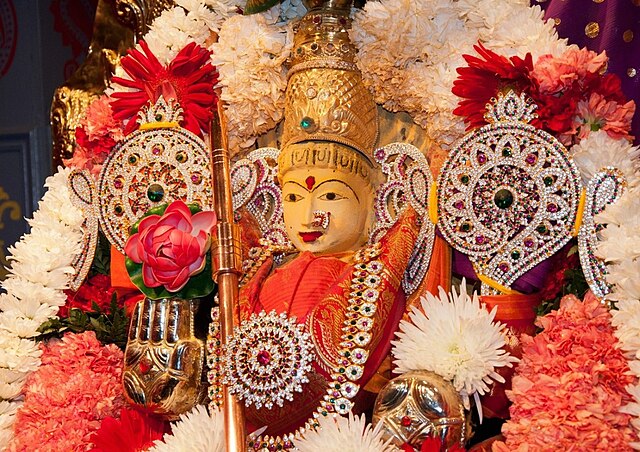Top Qs
Timeline
Chat
Perspective
Parashakti
Goddess in Shaivism From Wikipedia, the free encyclopedia
Remove ads
Parashakti (IAST: Paraśakti, Sanskrit: पराशक्ति)[1] or Parā is one of the three chief goddesses in Trika system of Kashmir Shaivism along with Aparā and Parparā.[2] In Siddhantic perspective, Parashakti is the counterpart of Paramshiva. Paramshiva is used to describe the ultimate form of Shiva in Shaiva Siddhanta and Kashmiri Shaivism. Parashakti is the power of this primordial Shiva, who is emanated by Paramshiva. Adi Parashakti is used to describe the Divine Mother (Supreme Feminine Energy/Mother of whole creation) in Hindu scriptures.[3] Parashakti is an all-pervasive, pure consciousness, power, and primal substance of all that exists and it has Mahamaya-form, unlike Parashiva which is formless.[4] A Parashakti as the supreme being of puranic Shaktism and of Sri Vidya obtained the name Adi Parashakti and Maheshvari-Devi.


Remove ads
Parā in Trika
Trika is a Non-Saiddhantic Mantra Margic Saivite sect that praises Parā, Aparā, and Parāparā as three supreme goddesses. These three represent the three prongs of Shiva's Trishula and they can be meditated upon in the Trishulabja Mandala. The three aspects emerge from Kulesvari Matrrusadbhava. Para means the highest form, beyond the range of human understanding. When it loses its transcendence and manifests, it becomes Parapara, the mediocre level. When it further loses its strength, it becomes Apara.[5] These three aspects symbolize Shiva, Shakti and Atman in the philosophical perspective of Trika.
Remove ads
Para in Siddhanta
According to Saiva Siddhanta, the lower part (pedestal) of Shiva lingam represents parashakti while upper part (oval stone) represents parashiva.[6]
This section needs expansion. You can help by adding to it. (January 2018) |
Para in Shaktism
This section needs expansion. You can help by adding to it. (November 2018) |
See also
References
Wikiwand - on
Seamless Wikipedia browsing. On steroids.
Remove ads
